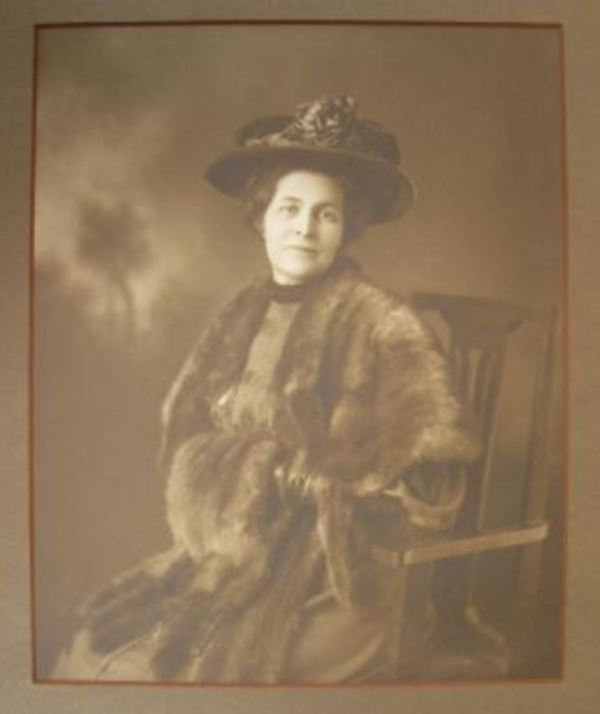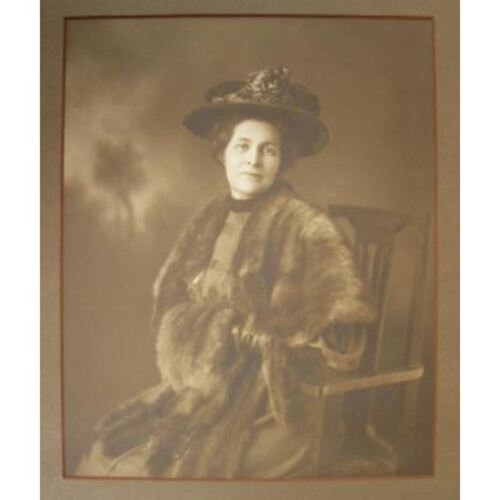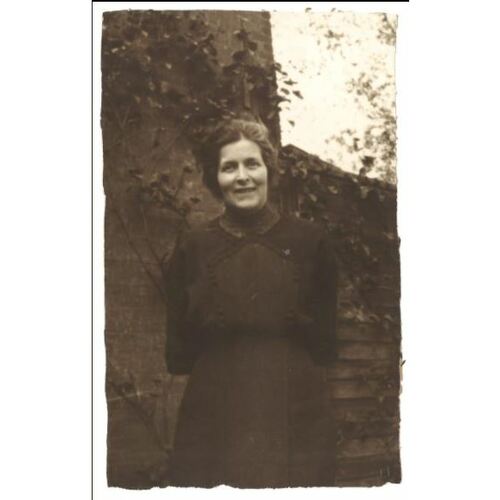
Source: Link
SCOTT, EMMA (Ema) PRISCILLA (Raff; Nasmith), educator and author; b. c. 1868 in Waterdown (Hamilton), Ont., daughter of the Reverend James Scott and Elizabeth Cunningham, both of Irish birth; m. first 6 June 1894 William Bryant Raff (d. 1897) in Owen Sound, Ont., and they had one daughter; m. secondly 20 Jan. 1916 George Gallie Nasmith* in Toronto; they had no children; d. there 16 Feb. 1940.
Emma Scott was raised in Owen Sound, where her reputedly silver-tongued father served as a Methodist minister, and graduated from the collegiate institute there. In a pamphlet entitled I’m going home, she recalls her childhood and remembers her father’s after-dinner readings to the family in his study: “’Twas there we learned to love Shakespeare.” She and her five siblings believed he “had done us all an injustice to be a Minister rather than a more prosperous citizen.”
After leaving school, Scott attended art classes given by George Agnew Reid* in Toronto. By the early 1890s she was running an art studio in Owen Sound. She subsequently made her way to Colorado, apparently as a member of a travelling theatre group. There she met William Bryant Raff, a Philadelphia-born mining accountant who lived in Aspen. Following their marriage, she adopted Scott Raff as her surname, offered art lessons in Aspen, and gave birth to a daughter, Dorothy Victoria, in 1895. Because of her husband’s ill health, the family journeyed to Arizona and then to Owen Sound, where they hoped he might be nursed back to health but where he died of pulmonary tuberculosis on 5 July 1897.
Leaving her daughter, at least for a time, with her widowed mother in Owen Sound, Emma returned to Toronto. She studied with Harold Nelson Shaw, head of elocution and dramatic art at the Toronto Conservatory of Music, founded by Edward Fisher*. In 1899 she transferred with Shaw to the Toronto College of Music [see Frederick Herbert Torrington*] and became his assistant in his new role as principal of its School of Elocution, Oratory, Physical Culture and Dramatic Art. She would teach at the school following her graduation in 1900. That fall she was also hired to teach physical training to women at Victoria College.
Scott Raff began her own school in 1901, offering instruction in voice culture, physical education, and literature. While running it, she acted from 1902 to 1913 as director of physical education at Victoria’s Annesley Hall [see Margaret Eleanor Theodora Addison] and in 1903–6 as principal of the school of elocution at the Toronto College of Music. In 1909 she began her lifelong association with the Heliconian Club, founded that year as the women’s counterpart to the all-male Arts and Letters Club. At various times during her early career she took courses at Victoria College and at the University of Toronto; she also continued her lessons in elocution, attending the Curry School of Expression in Boston and the Academy of Dramatic Art (later the Royal Academy of Dramatic Art) in London, England. She was reported by the Toronto Daily Star to have studied mimicry in London with actor Hermann Vezin and pantomime with dancer Malvina Cavallazzi (Cavalazzi). She apparently found time as well to attend lectures at the University of Oxford, study in France, and pursue archaeology in Greece. Travel, whether to Europe, to the United States, or to cottage country north of Toronto, would remain an interest throughout her life.
One of the early part-time students at her School of Expression was Margaret Wilson Eaton, wife of Timothy Eaton*, the founder of Toronto’s premier department store. Emma persuaded Margaret that her conservative Methodist husband should be asked to provide approximately $50,000 for a building to accommodate the school. Modelled on the National Library of Greece in Athens and known locally as “the Greek Temple,” the structure was completed in 1906 and opened early the next year as the home of what was now called the Margaret Eaton School of Literature and Expression. Chancellor Nathanael Burwash* of Victoria was the first chair of the school’s board of directors.
The threefold education of the mind, soul, and body through elocution, drama, and physical training was implemented at the school for mostly well-to-do pupils. Although Scott Raff believed that “all culture should carry with it a bread-winning power,” she insisted on offering more than vocational training. Shakespeare and Browning were the principal works studied. One student recalled that Scott Raff was “sold on Browning” and attracted “a lot of people who thought it was the thing to do to talk about Browning.” Reflecting Emma’s Irish ancestry, the school offered plays from the Irish Literary Renaissance (including the nationalistic Cathleen ni Houlihan by William Butler Yeats and Isabella Augusta, Lady Gregory); its theatre was apparently the first in Canada to do so. According to drama historian Anton Wagner, these productions, directed by Scott Raff, marked the start of the Little Theatre Movement in Toronto. Emma wrote one play, The message, originally called Love will find a way, which would be produced as part of the school’s graduation exercises in June 1920. The play is set in an upper-class Canadian home and involves proper manners, a “Negro” servant with slang speech, a Ouija board, and the Bible.
Described that year as “tall and graceful, with a refreshing simplicity of manner and dress,” Scott Raff was a woman of high culture, though some felt she was snobbish and superficial. It mattered to Emma that students came from “well-regulated” upper-class milieux. Family was important to her, and she passed on her love for drama and physical education to her daughter, who graduated from the Margaret Eaton school in 1917, and to her grandchildren. Her marriage to George Nasmith, a bacteriologist with the Canadian Army Medical Corps, had taken place while he was on furlough in 1916. He was a very short man whom Emma reportedly described to her students as having “an ugly little body but a pure white soul.” Arranged hastily, the wedding service lasted only a few minutes in front of a handful of witnesses before the newly married couple boarded a train to New York so that George could return to the war. The union, she told him four days later, had made her “unspeakably happy.”
Managing finances was a weakness of Scott Nasmith’s, and by 1924 the school had accumulated debts of $39,000. With more students choosing physical education rather than the theatrical training that was Margaret Eaton’s real interest, with Mrs Eaton declining to pay further cost overruns, and with the city having expropriated the school’s property to widen North (Bay) Street, the school’s board of directors, which included executive members of the T. Eaton Company, wanted to put a quiet end to the institution. In protest Emma tendered her resignation as principal in September 1924. Arguing that not even Margaret Eaton could close the school, she made an emotional appeal to the board the following year: “Timothy Eaton never started anything to let it die and he absolutely refused to believe in Divorce. I remember, as if it were yesterday, when the name of the New School was being discussed I suggested that Margaret Eaton be added to School of Expression he said – ‘Mother [his wife] will like that.’” She urged the board to keep faith with the man who was “the founder of all your fortunes.”
Renamed the Margaret Eaton School (MES) in 1925, the institution continued to struggle. It was saved by Mary Grace Hamilton, who became principal the following year and turned the establishment into a self-governing, self-financing normal school for women interested in physical training. In 1941 the MES would join with the University of Toronto in beginning the first bachelor’s program in physical education in Canada. The school provided the university with students, faculty, a library, and a tradition that legitimized physical culture. By then the institution that Emma had founded had graduated approximately 450 women in the areas of elocution and physical education. Actor Dora Mavor* Moore was one of the outstanding alumnae.
Emma Scott Nasmith died of a heart attack on 16 Feb. 1940. Writing in the Toronto Daily Star on the 24th, arts critic Augustus John Bridle* noted that there were “scores of folk at the funeral … [whose] first impulses to beauty in music and drama were the work of this luminous apostle.”
Published works by Emma Priscilla Scott (Raff; Nasmith) include Of queen’s gardens and I’m going home, two pamphlets issued privately, the first around 1914 and the second likely in early 1920. She is also the author of “The message” (n.p., n.d.).
Two video clips of Scott Nasmith may be viewed at youtu.be/0yIgSXyhVTw and youtu.be/WnYfpGdztIU (both consulted 28 Aug. 2018). Through the generosity of her great-grandson Robert Fennell Young, much material relating to her and the Margaret Eaton School, including manuscripts, printed documents, images, and secondary works, has been placed online by Redeemer Univ. (Ancaster, Ont.) as “The Margaret Eaton School digital collection”: libguides.redeemer.ca/MES (consulted 28 Aug. 2018); the collection includes some of the subject’s correspondence as well as typescripts of her plays. Her correspondence is also found in the Eaton collection at AO (F 229).
Two dissertations have been written on the school and its principal: John Byl, “The Margaret Eaton School, 1901–1942: women’s education in elocution, drama and physical education” (phd thesis, State Univ. of N.Y. at Buffalo, 1992); and A. H. Lathrop, “Elegance and expression, sweat and strength: body training, physical culture and female embodiment in women’s education at the Margaret Eaton schools (1901–1941)” (edd thesis, Univ. of Toronto, 1997). The first is based in part on interviews with former students of the school. Its author has subsequently benefited from correspondence with Robert Fennell Young about his family.
UTARMS, A1973-0026 (Univ. of Toronto, dept. of graduate records), box 403, file 11. Evening Telegram (Toronto), 17 Feb. 1940: 3. Hilda Ridley, “Pen portraits of progressive women: Mrs. Geo. G. Nasmith,” Christian Guardian (Toronto), 13 Oct. 1920: 12. Toronto Daily Star, 17 Feb. 1940: 25; 24 Feb. 1940: 24. John Byl, “Directing physical education in the Canadian YWCAs: Margaret Eaton School’s influence, 1901–1947,” Sport Hist. Rev. (Champaign, Ill.), 27 (May–November 1996): 139–54. “Canadian women in the public eye: Mrs. G. G. Nasmith,” Saturday Night, 11 Sept. 1920: 26. The Oxford companion to Canadian theatre, ed. Eugene Benson and L. W. Conolly (Toronto, 1989), 139, 399.
Cite This Article
John Byl, “SCOTT, EMMA PRISCILLA (Raff; Nasmith),” in Dictionary of Canadian Biography, vol. 16, University of Toronto/Université Laval, 2003–, accessed March 27, 2025, https://www.biographi.ca/en/bio/scott_emma_priscilla_16E.html.
The citation above shows the format for footnotes and endnotes according to the Chicago manual of style (16th edition). Information to be used in other citation formats:
| Permalink: | https://www.biographi.ca/en/bio/scott_emma_priscilla_16E.html |
| Author of Article: | John Byl |
| Title of Article: | SCOTT, EMMA PRISCILLA (Raff; Nasmith) |
| Publication Name: | Dictionary of Canadian Biography, vol. 16 |
| Publisher: | University of Toronto/Université Laval |
| Year of revision: | 2022 |
| Access Date: | March 27, 2025 |




